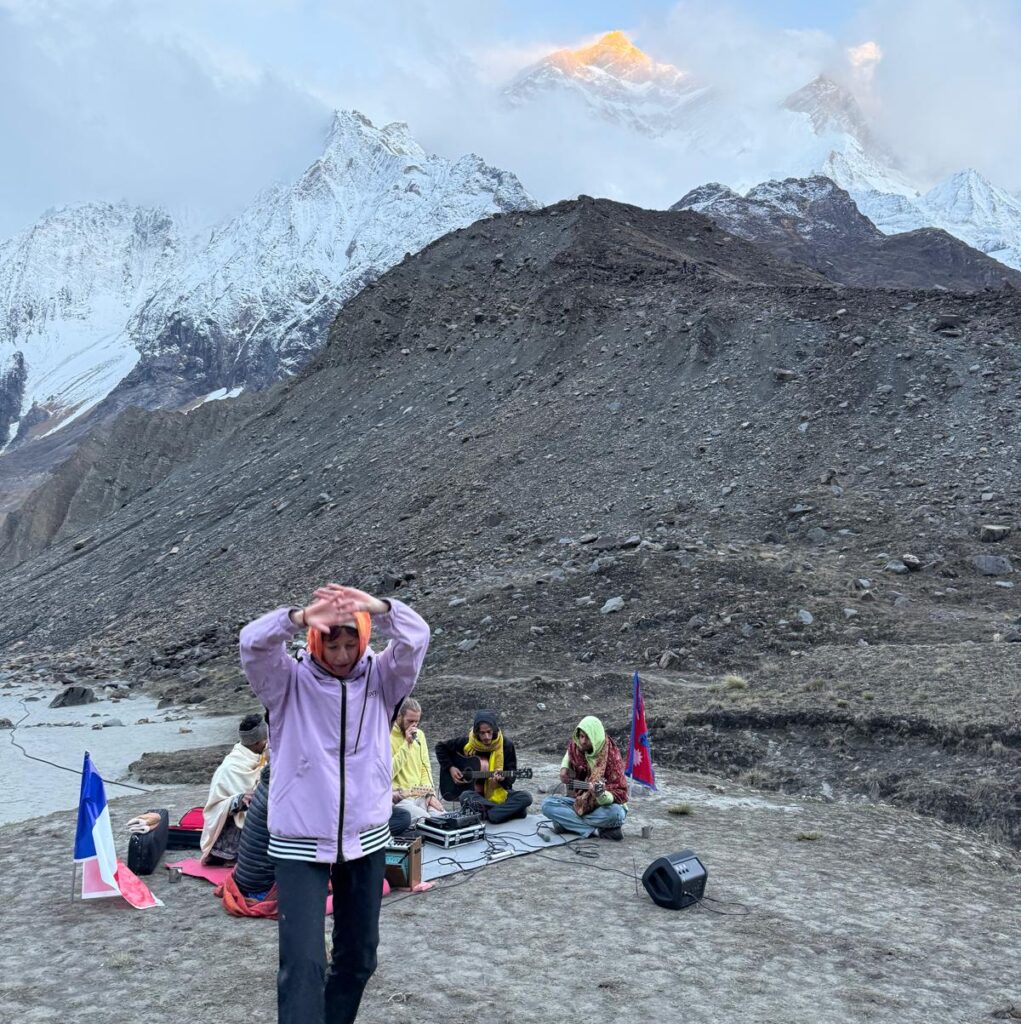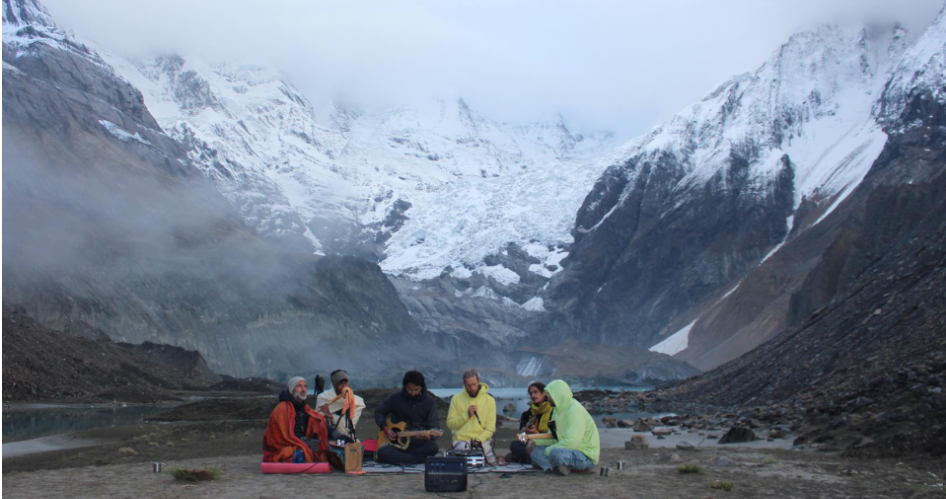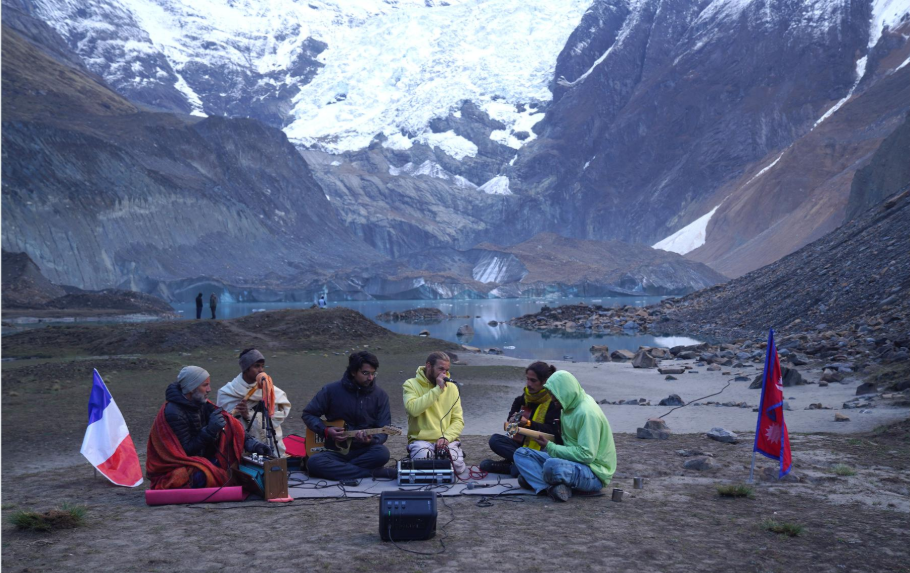In a landmark moment for Nepal’s mountaineering and cultural tourism, French music echoed for the first time at the Annapurna I Base Camp, located at an altitude of 4,050 meters in Annapurna Rural Municipality–4, Narchyang, Myagdi. This unprecedented musical event took place on Tuesday during the “Annapurna Diamond Jubilee Festival,” organized to mark the 75th anniversary of the first successful ascent of Annapurna I (8,091 meters), the tenth-highest mountain in the world.
The highlight of the festival was a captivating live musical performance by a group of French, British, and Indian musicians and dancers. The ensemble was led by Mathias Herzog, the son of the legendary French mountaineer Maurice Herzog, who, along with Louis Lachenal, made history in 1950 by becoming the first to summit Annapurna I.
This powerful performance served as a symbolic tribute to that pioneering ascent, which firmly established Nepal as a key destination on the global mountaineering map. Despite challenging weather conditions during the event, the atmosphere turned spiritual and uplifting as attendees began chanting in reverence to Surya, the Sun God, and the Annapurna deity. Remarkably, following an avalanche, the sun broke through the clouds and appeared atop Annapurna, a moment many witnessed as a divine sign, captured in an unforgettable photograph.

Fusion of French and Nepali Music Enchants Visitors
The French musical group, named the “Annapurna Music Group,” mesmerized the audience with a harmonious fusion of French compositions and Nepali-inspired melodies. Incorporating traditional Nepali instruments such as the harmonium, flute, and guitar, the group, featuring artists from France, Britain, and India, crafted an immersive musical experience that celebrated cultural unity. Their soulful performance echoed across the snow-covered Himalayan landscape, leaving a lasting impression on both domestic and international tourists gathered at the Annapurna Base Camp.
Tej Gurung, a member of the Annapurna Diamond Jubilee Festival organizing committee and a long-time advocate of the Annapurna trekking trail, shared his excitement, saying, “This is the first time a musical program of this kind has been held at the Annapurna Base Camp. The performance by French artists has inspired us to consider hosting similar events in the future.”
In addition to the musical performances, the artists showcased traditional French dances, further adding vibrancy and diversity to the event. The performances took place near the serene Panchakunda Lake, nestled in the lap of Annapurna, where both Nepali and international visitors gathered enthusiastically to witness the occasion.
Music as a Tool for Tourism Promotion
The celebration, rich in cultural and emotional significance, was not only a tribute to the pioneers of Himalayan mountaineering but also a strategic event for promoting tourism in the region. Krishna Prasad Acharya, President of the Trekking Agencies’ Association of Nepal (TAAN) Gandaki Chapter, led a commemorative trek to the base camp. He emphasized the potential of music and art in elevating the appeal of tourist destinations like Annapurna.
“Using music as a medium to promote tourism is a creative approach that adds emotional and cultural value to the experience,” Acharya stated. “Such initiatives can attract more visitors to the region and showcase Nepal’s diversity beyond trekking and mountaineering.”

Statues Unveiled in Honor of Climbing Legends
As part of the celebration, the organizing committee unveiled bust statues of legendary mountaineers Maurice Herzog, Louis Lachenal, and Sonam Wangchuk Sherpa, the first Nepali climber to summit Annapurna I. These installations at the base camp serve as a lasting tribute to the heroes of Himalayan climbing and aim to educate and inspire future generations of mountaineers.
The joint effort was led by the Annapurna Rural Municipality in collaboration with the Nepal Tourism Board, Nepal Mountaineering Association (NMA), Trekking Agencies’ Association of Nepal (TAAN), Annapurna Conservation Area Project (ACAP), and the Annapurna Rural Municipality Tourism Development Committee.
More Than Music: Marathons and Cultural Performances
The Diamond Jubilee celebration was not limited to music alone. The organizers hosted a marathon covering approximately 36 kilometers from the base camp down to Narchyang village, symbolizing endurance, passion, and the human spirit that the Annapurna region embodies. This sporting event added an adventurous flair to the occasion and attracted runners from across the region.
Traditional Nepali dances and cultural exhibitions also colored the festival, providing visitors a glimpse into the rich heritage of the Annapurna region. These performances featured local ethnic groups and portrayed their traditional way of life, giving tourists an authentic cultural experience.
A New Milestone for Cultural Tourism in the Himalayas
The Annapurna Diamond Jubilee Festival has not only celebrated a historical mountaineering feat but also established a new precedent for incorporating arts, music, and cultural heritage into high-altitude tourism. It showcased how creative experiences, when blended with natural grandeur and historical significance, can enhance the attractiveness of a destination.
Organizers hope that the success of this unique event will encourage more collaboration between local communities and international artists in the future. The celebration reaffirmed that Annapurna is not just a destination for trekkers and climbers, but also a place where art, history, and culture can converge at the top of the world.
As the melodies of French music fade into the Himalayan winds, the memory of this festival is sure to echo in the hearts of those who witnessed a rare fusion of art and altitude, ushering a new era for Nepal’s tourism narrative.






